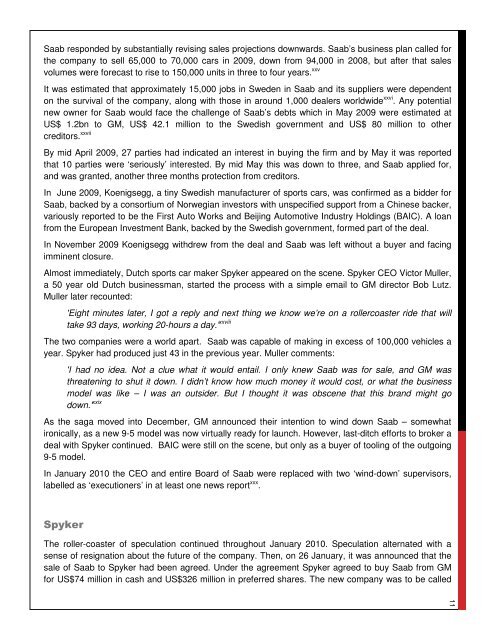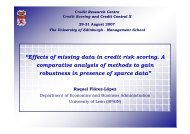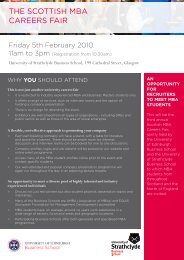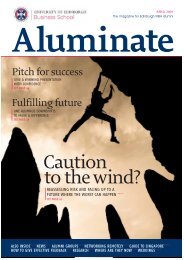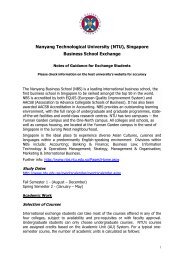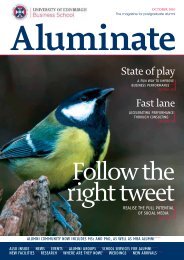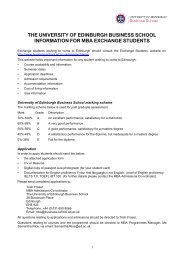killed Saab Automobile? - Business School - University of Edinburgh
killed Saab Automobile? - Business School - University of Edinburgh
killed Saab Automobile? - Business School - University of Edinburgh
You also want an ePaper? Increase the reach of your titles
YUMPU automatically turns print PDFs into web optimized ePapers that Google loves.
<strong>Saab</strong> responded by substantially revising sales projections downwards. <strong>Saab</strong>’s business plan called for<br />
the company to sell 65,000 to 70,000 cars in 2009, down from 94,000 in 2008, but after that sales<br />
volumes were forecast to rise to 150,000 units in three to four years. xxv<br />
It was estimated that approximately 15,000 jobs in Sweden in <strong>Saab</strong> and its suppliers were dependent<br />
on the survival <strong>of</strong> the company, along with those in around 1,000 dealers worldwide xxvi . Any potential<br />
new owner for <strong>Saab</strong> would face the challenge <strong>of</strong> <strong>Saab</strong>’s debts which in May 2009 were estimated at<br />
US$ 1.2bn to GM, US$ 42.1 million to the Swedish government and US$ 80 million to other<br />
creditors. xxvii<br />
By mid April 2009, 27 parties had indicated an interest in buying the firm and by May it was reported<br />
that 10 parties were ‘seriously’ interested. By mid May this was down to three, and <strong>Saab</strong> applied for,<br />
and was granted, another three months protection from creditors.<br />
In June 2009, Koenigsegg, a tiny Swedish manufacturer <strong>of</strong> sports cars, was confirmed as a bidder for<br />
<strong>Saab</strong>, backed by a consortium <strong>of</strong> Norwegian investors with unspecified support from a Chinese backer,<br />
variously reported to be the First Auto Works and Beijing Automotive Industry Holdings (BAIC). A loan<br />
from the European Investment Bank, backed by the Swedish government, formed part <strong>of</strong> the deal.<br />
In November 2009 Koenigsegg withdrew from the deal and <strong>Saab</strong> was left without a buyer and facing<br />
imminent closure.<br />
Almost immediately, Dutch sports car maker Spyker appeared on the scene. Spyker CEO Victor Muller,<br />
a 50 year old Dutch businessman, started the process with a simple email to GM director Bob Lutz.<br />
Muller later recounted:<br />
'Eight minutes later, I got a reply and next thing we know we’re on a rollercoaster ride that will<br />
take 93 days, working 20-hours a day.' xxviii<br />
The two companies were a world apart. <strong>Saab</strong> was capable <strong>of</strong> making in excess <strong>of</strong> 100,000 vehicles a<br />
year. Spyker had produced just 43 in the previous year. Muller comments:<br />
'I had no idea. Not a clue what it would entail. I only knew <strong>Saab</strong> was for sale, and GM was<br />
threatening to shut it down. I didn’t know how much money it would cost, or what the business<br />
model was like – I was an outsider. But I thought it was obscene that this brand might go<br />
down.' xxix<br />
As the saga moved into December, GM announced their intention to wind down <strong>Saab</strong> – somewhat<br />
ironically, as a new 9-5 model was now virtually ready for launch. However, last-ditch efforts to broker a<br />
deal with Spyker continued. BAIC were still on the scene, but only as a buyer <strong>of</strong> tooling <strong>of</strong> the outgoing<br />
9-5 model.<br />
In January 2010 the CEO and entire Board <strong>of</strong> <strong>Saab</strong> were replaced with two ‘wind-down’ supervisors,<br />
labelled as ‘executioners’ in at least one news report xxx .<br />
Spyker<br />
The roller-coaster <strong>of</strong> speculation continued throughout January 2010. Speculation alternated with a<br />
sense <strong>of</strong> resignation about the future <strong>of</strong> the company. Then, on 26 January, it was announced that the<br />
sale <strong>of</strong> <strong>Saab</strong> to Spyker had been agreed. Under the agreement Spyker agreed to buy <strong>Saab</strong> from GM<br />
for US$74 million in cash and US$326 million in preferred shares. The new company was to be called<br />
11


